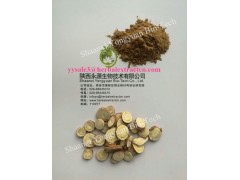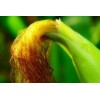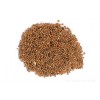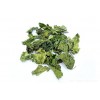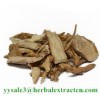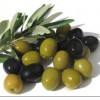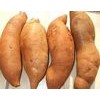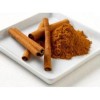Latin Name: Radix Glycyrrhizae
Part Used: Root
Main content: glycyrrhizic acid 24% HPLC
CAS NO.: 1405-86-3
Molecular formula: C42H62O16
Molecular weight: 822.92
Appearance: Brown-yellow
Place of origin: China
Description: Licorice is the root of Glycyrrhiza glabra from which a sweet flavour can be extracted. Glycyrrhizic acid is the chief sweet-tasting constituent of Glycyrrhiza glabra(liquorice) root. Structurally it is a saponin and has been used as an emusifier and gel-forming agent in foodstuff and cosmetics.
Main function
1.Glycyrrhizic acid has the efficacy in antianaphylaxis and moist boost;
2. Has the effect of strong anti-oxidation and antibacterial effect;
3.Can be used for the situation of low-calorie, innocuity and health care;
4.Glycyrrhizic acid with the function of anti-flammation, antivirus, antimicrobial activity and liver protection.
5.Moistens the lungs and stops coughs. It treats disorders such as shortness of breath, fatigue, sallow facial appearance, decreased food intake, loose stools, and diarrhea.
6.Has effect of detoxification, pain reliefm.Also used to ease the drug toxicity, strong effect.
7. clear heat and toxins; it is useful to treat poisoning due to foods, herbs, herbicides, pesticides, drugs and heavy metals.
Application
1.Applied in cosmetic industry, glycyrrhizic acid is used for skin refresher lotion and facial cream;
2.Applied in Pharmaceuticals industry, glycyrrhizic acid is uesd as the material of eyedro and officinal toothpaste;
3.Applied in food industry,glycyrrhizic acid is used as sweetening agent, antistaling agent and flavouring agent for sports drinks.
Storage: Store at cool&dry place.Protect from light,moisture and pest infestation.
Shelf life: 2 years when properly stored.
Product Name: Licorice Root Extract
Latin Name: Radix Glycyrrhizae
Part Used: Root
Main content: Glabridin 40% 98% HPLC
CAS NO.: 59870-68-7
Molecular formula:C20H20O4
Molecular weight: 324.3704
Appearance: Brown to white powder
Place of origin: China
Description: Licorice is the root of Glycyrrhiza glabra from which a sweet flavour can be extracted. Glabridin is a chemical compound that is found in the root extract of licorice(Glycyrrhiza glabra). Glabridin is an isoflavane, a type of isoflavonoid. This product is part of a larger family of plant-derived molecules, the natural phenols.It is used as an ingredient incosmetics and is listed in Intenational Nomenclature of Cosmetic Ingredients (INCI).Glabridin, a prenylated isoflavonoid of G. glabra L. roots (European licorice, Fabaceae),hasbeen associated a wide range of biological properties such as antioxidant, anti-inflammatory,antiatherogenic, regulation of energy metabolism, estrogenic, neuroprotective, anti-osteoporotic,and skin-whitening. While glabridin is one of the most studied licorice flavonoids,
a comprehensive literature survey linked to its numerous bioactivities is unavailable.
Main function
1. Skin whitening. Glabridin is able to penetrate deep into the skin and maintain high activity, whitening skin. Effectively inhibit the formation of melanin and antioxidant.
2.It also has the effect of preventing the skin from rough and anti - inflammatory and antibacterial.
3.It the effect of UV absortion, skin whitening, spot removing.
4.It is used to cure gastritis, ulcer, liver-caring, prevention for atherosclerosis and females’ osteoporosis after their climacterium.
Application
1.Applied in cosmetic industry.
2.Applied in health product industry.officinal toothpaste;
3.Applied in food additives.
4.Applied in dietary supplements.
Storage: Store at cool&dry place.Protect from light,moisture and pest infestation.
Shelf life: 2 years when properly stored.
| Item | Specification | Method |
| Drying Method | Spray Drying | |
| Physical Charactristics | ||
| Partical Size | NLT100%Through 80 mesh | GB 5507-2008 |
| Loss on Drying | ≤5% | GB 5009.3-2010 |
| Ash | ≤5% | GB 5009.4-2010 |
| Bulk Density | 40-60g/100ml | |
| Pesticide Residue | ||
| 666 | <0.2ppm | GB/T5009.19-2008 |
| DDT | <0.2ppm | GB/T5009.19-2008 |
| Heavy metals | ||
| Total Heavy metals | ≤10ppm | CP2010 |
| Arsenic | ≤2ppm | CP2010 |
| Lead | ≤2ppm | CP2010 |
| Mercury | ≤2ppm | CP2010 |
| Microbiological Tests | ||
| Total Plate Count | ≤10000cfu/g | GB 4789.2-2010 |
| Total Yeast & Mold | ≤300cfu/g | GB 4789.15-2010 |
| E.Coli | Negative | GB 4789.3-2010 |
| Salmonelia | Negative | GB 4789.4-2010 |
| Staphylococcus | Negative | GB 4789.10-2010 |


